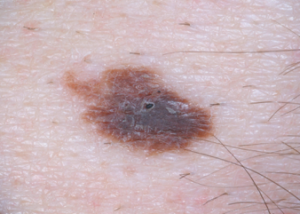
If a middle age person suddenly gets several new moles, does this mean they’ll continue getting new moles for the rest of their life and thus have to worry about melanoma?
It’s more common for kids than middle age adults to notice the development of several new moles that seem to have popped up at the same time.
Growth of new moles continues throughout a person’s life. There is no abrupt cut-off age.
However, with each decade after age 30, the likelihood of new moles developing, especially several at the same time, drops.
What percent this drops with each decade is not known.
But even senior aged people can acquire new, and benign, moles.
A new mole in an older person is more likely to develop into melanoma when compared to a new mole in a child or young adult.
This doesn’t mean that several new normal-looking moles in middle age or older equates to the same level of alarm as if that person were to start passing bloody stools.
Multiple Moles Popping Up At Once
Does the growth of several new moles at the same time mean that a new trend has been established for the rest of the person’s life?
“This question really can’t be answered,” says Dr. Jennifer Gordon, who is board certified by the American Board of Dermatology; she practices at Westlake Dermatology located in Austin, Texas.
“Genetics plays a large role in nevi [moles] development but so does environment.
“There are also many medical factors that can play a role (hormones, for instance).
“There are certain people who develop many nevi and will continue to develop nevi throughout their life (likely still slowing down after age 30).
“There is also something called dysplastic nevus syndrome, where patients make many atypical nevi.
“Either one of your options is a possibility, and although there may be some predictors, there is nothing consistent enough to be able to tell a patient whether they will continue to develop moles or not.”
Just what is a mole?
A mole, also known as a nevus, is formed by clusters of pigment-producing cells called melanocytes.
They can vary in color, ranging from light brown to black, and can be flat or raised.
Moles are usually round or oval and may have a smooth or slightly irregular border.
Moles can appear anywhere on the body and may change over time, often becoming more noticeable with age. But they may also fade over time.
Changes in size, shape, color or texture, or the development of new moles, should be brought to the attention of your dermatologist.

Dr. Gordon’s interests include medical dermatology, particularly the treatment and prevention of melanoma and other skin cancers in athletes. For 2016, 2017 and 2018 Texas Monthly Magazine selected her as one of the Texas Super Doctors Rising Stars.
 Lorra Garrick has been covering medical, fitness and cybersecurity topics for many years, having written thousands of articles for print magazines and websites, including as a ghostwriter. She’s also a former ACE-certified personal trainer.
Lorra Garrick has been covering medical, fitness and cybersecurity topics for many years, having written thousands of articles for print magazines and websites, including as a ghostwriter. She’s also a former ACE-certified personal trainer.
.









































